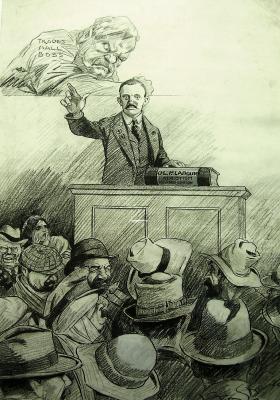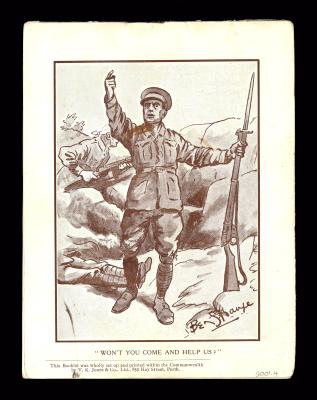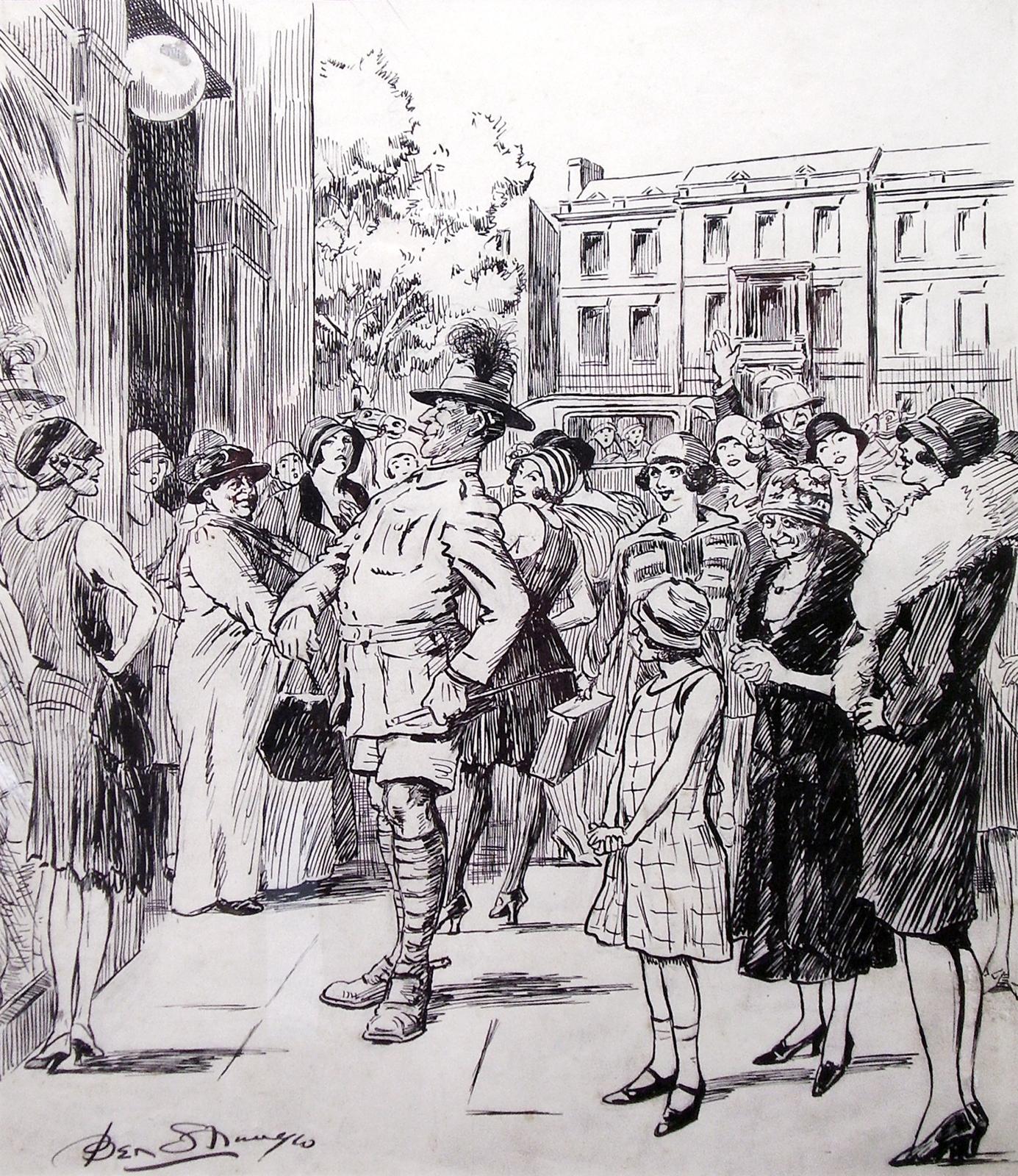CARTOON - IN PRAISE OF BEAUTY
1929Scene of a soldier standing proud in his uniform which includes tunic, hat with feather, shorts, shoes and either socks of putties. He is holding in one hand a riding crop and a handbag in the other. He is standing on a street in front of shops. Surrounding him are numerous women in dress from the 1920's looking at the soldier.
Ben Strange signature bottom left
The cartoon was published in the Western Mail on 28 February 1929 with the following caption:
Sir Thomas Legge (Medical Inspector of Factories) in a lecture on physical beauty before the Society of Arts in London on February 17 said that the most handsome men the world had ever seen were found among the first 100,000 Australians who came over during the war. All of them seemed to conform to the highest class of beauty, having narrow faces, straight foreheads and noses, high cheek bones, short upper lip, strong chins, thick hair and magnificent figures.
'In Praise of Beauty' was first published in the Western Mail on February 29, 1929, page 7 in the 'Bit of Life' section of the newspaper. The cartoon shows an Australian soldier admiring his reflection in a window. He is standing on the footpath of a busy London street surrounded by numerous women of all classes and ages (the building is suggestive of Australia House, in London, which was completed in 1918) . The soldier has a Light Horse slouch hat complete with puggaree and an emu plume. He wears shorts with his AIF tunic, along with boots and puttees. He has a cigarette in his mouth and is holding a swagger stick and what seems to be a handbag. The handbag contrasts with the briefcase held by a young woman standing close by. Despite being surrounded by so many attractive women the soldier, with chest puffed out in self-admiration, only has eyes for himself.
The writing beneath the cartoon reads:
Sir Thomas Legge (Medical Inspector of Factories) in a lecture on physical beauty before the Society of Arts in London on February 17 said that the most handsome men the world had ever seen were found among the first 100,000 Australians who came over during the war. All of them seemed to conform to the highest class of beauty, having narrow faces, straight foreheads and noses, high cheek bones, short upper lip, strong chins, thick hair and magnificent figures.
The stares of others in the cartoon, including a waving man and a horse, are difficult to read. Are they also struck by the beauty of the soldier? They could, in fact, be smirking at his self-obsession - the shorts are not attractive. I’m not sure.
Analysis
The cartoon is meant to be read ironically. Strange is poking fun at this rather ridiculous soldier, so fascinated by his own good looks that he cannot see anything else. The handbag is interesting - does this take the parody to an extreme, equating the soldier’s interest with his own beauty as feminine in its intensity? Strange is making fun of the words used by Sir Thomas Legge to describe the best of Australian manhood as ‘the highest class of beauty’.
Of course Legge’s comments, whilst extreme, echo the viewpoints of Australian contemporaries. With CEW Bean’s valorisation of the original Anzacs in The Official History of Australia in the War, 1914-1918 (1921-1942), many Australians of the time believed the Diggers were physically superior to their British counterparts.
From a British perspective, the industrialisation of many parts of the UK in the 19th and early 20th centuries resulted in a population that was regarded by many from the upper levels of society as diseased and dissolute. Poor health as a consequence of sub-standard diet and housing was especially apparent when young British working-class men signed up for WW1 and many were found to be unfit for service. In comparison, the first Australian and New Zealand troops to enlist were not only more physically able than their British counterparts but also proved to be tougher and more resilient in battle.
The admiration felt by Sir Thomas Legge for Australian soldiers is probably a response to his own situation where as medical inspector for factories he was constantly exposed to the physical effects of industrial life on working-class families in Britain.
1. Joanna Bourke, Dismembering the Male: Men’s Bodies, Britain and the Great War (London, 1996).
2. Peter Stanley, ‘Australia in World War One’, http://www.bbc.co.uk/history/worldwars/wwone/australia_01.shtml
Details
Details
Artist's signature bottom left [Ben Strange]
HIGH
The Ben Strange cartoons are historically significant as they depict many key figures linked to the history and development of both Western Australia and Australia. Political figures who regularly appeared in his cartoon’s included John ‘Happy Jack’ Scaddan, the Premier of Western Australia from 1911 until 1916, and William ‘Billy’ Hughes, the Prime Minister of Australia from 1915 to 1923.
With the outbreak of World War One Stranges’ focus broadened to include international political commentary as he keenly observed the conflict. The cartoons from this period provide insight into public opinion regarding the war. However, Strange did not neglect domestic matters, drawing cartoons concerned with wide-ranging issues including: the economic and social cost of gambling; taxation; Government debt; declining population; the White Australia Policy; shop lifting; and the campaign to introduce Western Australia’s first female officers. Therefore, the collection has particular associations with an evolving cultural identity, as well as significant local appeal.
The cartoons have high artistic significance due to the quality of execution. Ben Strange was a self-taught artist who had a knack for concisely encapsulating and commenting on the events of the day within his illustrations. His work was well regarded in the period, evidenced by his frequent inclusion in the English ‘Review of Reviews’. No other similar set of original drawings exists by this artist, or indeed by any other Australian cartoonist working within this period. The number and quality of these works adds considerably to the collection’s importance.
The cartoons are well provenanced, as Strange created the cartoons for the Western Australian readership of the Western Mail from 1898 till his death in 1930. The collection consists of 44 original cartoons drawn between 1912 and 1929, as well as ‘Blackboy Camp Souvenir’ booklet c1915. The cartoons in particular provide unique insight into not only Strange’s views on issues of local and national importance, but by extension, contemporary opinion on the issues of the day. The original cartoons were collected by Ivor T. Birtwistle, who worked at the Western Mail from the age of 15 as a copy-boy, and went on to become Editor of the paper in 1924. They were then gifted to History House museum by the Birtwistle Family, with the exclusion of ‘East is East, and West is West’ which was donated by Mrs Court.
BIBLIOGRAPHY
Australian Cartoon Museum, ‘Political’, ACM: An Online Museum for Australian Cartoons [website], http://www.theaustraliancartoonmuseum.com.au/category/cartoons/political/, accessed 6 July 2017.
City of Armadale - History House
City of Armadale - History House
Other items by Ben Strange
- CARTOON - THE CRUCIFICTION OF REASON
- CARTOON - IN TROUBLED WATERS
- CARTOON - EXCUSE ME I HAVE A DEPUTATION TO MEET
- CARTOON - THE LONG TREK FROM THE NORTH
- CARTOON - THE WATCH DOG
- CARTOON - THE ROAD TO ARMADALE
- CARTOON - SILENCE IS NOT ALWAYS GOLDEN - AND THE LAW MAKES A POOR CUPID
- CARTOON - THE DECIDING FACTOR
- CARTOON - LABOUR PARTY I MUST DISOWN ALL KNOWLEDGE OF THE OBSTRUCTIVE ASS
- CARTOON - TWO OF A KIND
- CARTOON - SWEET SIMPLICITY UNDER THE MISTLETOE
- CARTOON - LABOUR REFORM
Other items from City of Armadale - History House
- CARTOON - THE STRANGE ADVENTURE OF LITTLE NOT WANTED
- CARTOON - FINANCIAL RETURN
- CARTOON - ON A GOOD WICKET
- CARTOON - KING COAL'S GROWL
- CARTOON - TRANSFUSION OF BLOOD
- CARTOON - THE PREMIERS CONFERENCE BOVRILISED: BUT THE STATES LIVES IN HOPE
- CARTOON - SHE'S COMING! - THE NEW TERROR
- CARTOON - YOUR EYES HAVE TOLD ME SO
- AXE, FIREMAN'S
- SOUVENIR BOOKLET BLACKBOY CAMP
- PACKET HONEY LABELS
- COWLS OR COLLARS LOYAL ORANGE LODGE





